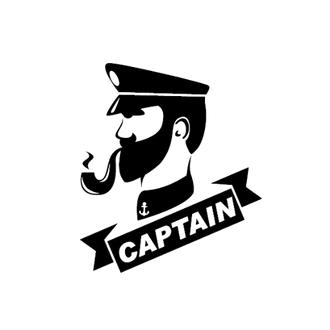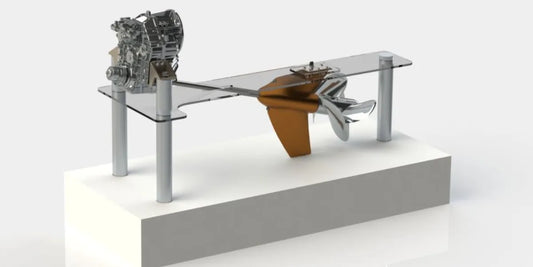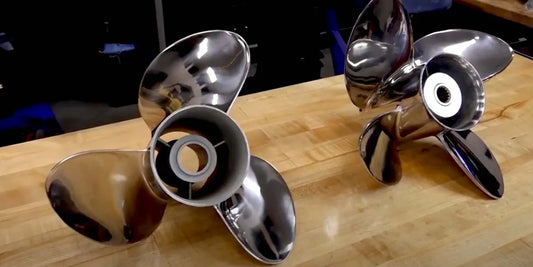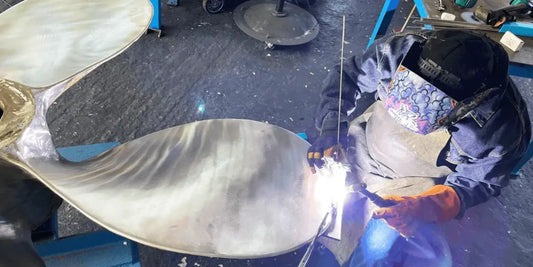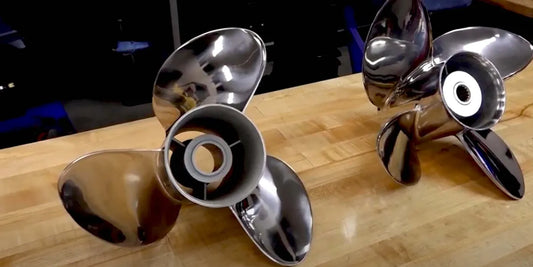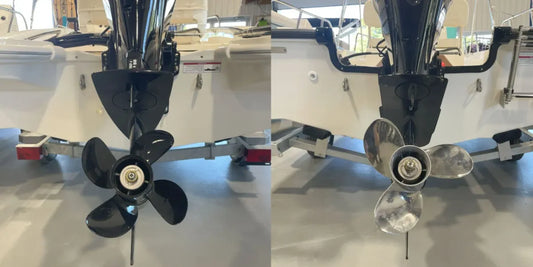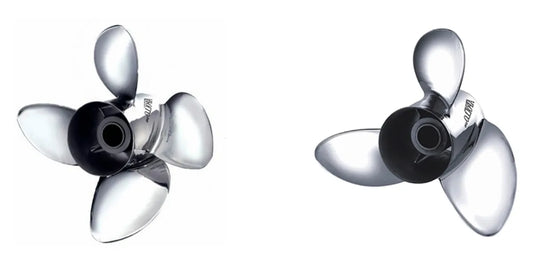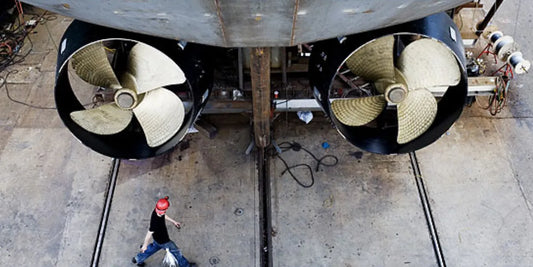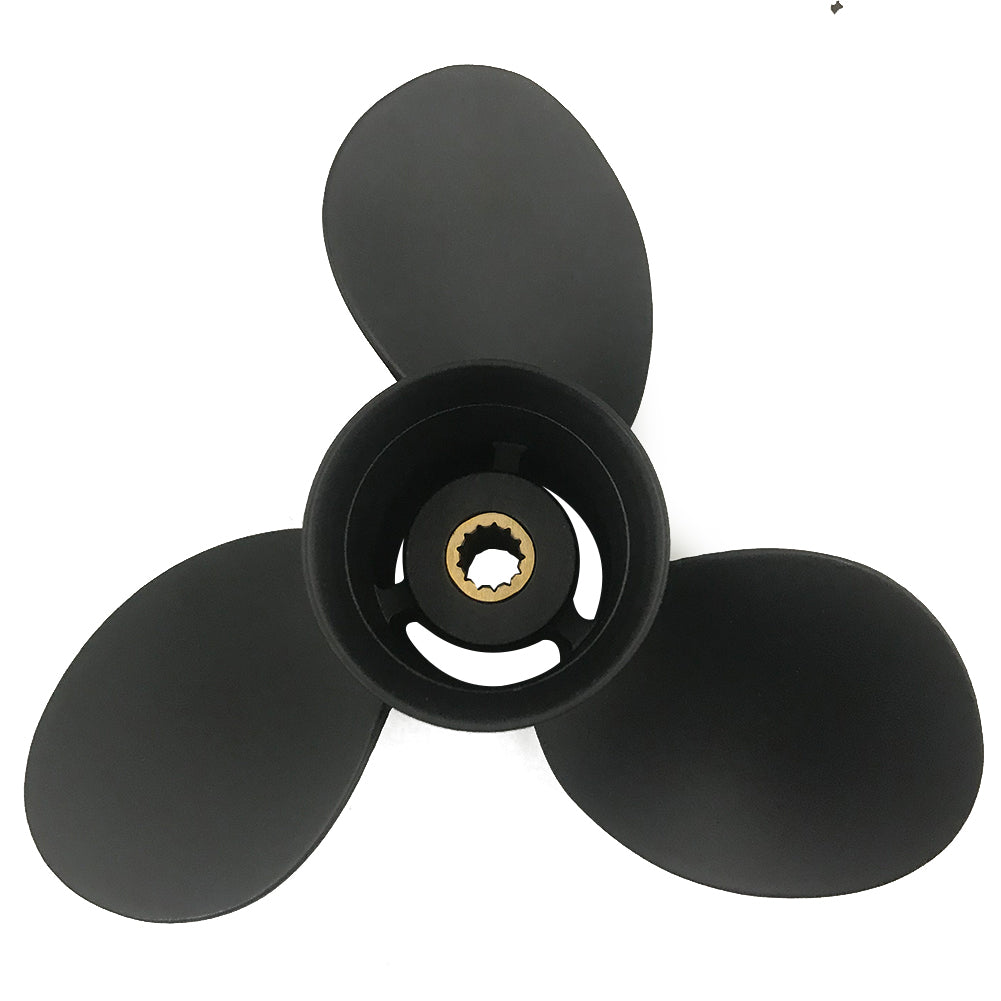When it comes to enhancing your boat's performance, selecting between 3-blade and 4-blade propellers is one of the big decisions that will greatly affect speed, handling, and fuel economy. Either of these options has its advantages, but it requires an understanding of the little peculiarities with which each design responds under different conditions. This article examines the fundamental differences between 3-blade and 4-blade propellers, providing you with the proper insight to make an informed decision. Whether top-end speed improvement, maneuverability, or stability is of concern, basic comparisons and expert advice will be your best bet to help you find the perfect propeller for your boat.
Understanding Propeller Basics

What do you Mean By A Propeller?
A propeller is a mechanical device used for producing propulsion by converting rotational motion into resultant linear motion, thereby pushing a vessel through water or air. It comprises blades attached around a central hub, with each working at a certain angle to induce pressure changes during rotation. Such pressure change results in a lift that essentially pushes the boat ahead. The propellers, being the most effective tool for transforming engine power into movement, are ideal in marine vessels of all types, ranging from small recreational crafts to large commercial ships.
Performance characteristics depend on several paramount factors, namely propeller diameter, pitch, number of blades, and the materials used in its manufacture. For example, the diameter controls the size of the circular area that the blades sweep, thus creating thrust. Pitch, on the other hand, refers to the distance that a propeller should practically traverse during one rotation through a solid medium, therefore affecting speed and efficiency. At the same time, the number of blades influences smoothness, speed, and maneuverability. Hence, a decision must be made with regard to the results required for the vessel. For example, stainless steel and aluminum are two materials commonly used, with stainless steel being hard-wearing and exhibiting excellent performance, especially under high-speed loads. Aluminum, on the other hand, is lighter but weaker, making it primarily suitable for low-power applications.
There are also categories of propellers, including fixed-pitch, variable-pitch, and controllable-pitch, each used for specific purposes. Fixed-pitch ones are most popular due to their simplicity and toughness, while variable-pitch and controllable-pitch types are favored for uses where utmost control and efficiency are required. Therefore, nothing draws attention to grasping the key specifications of the propeller's design and functioning to ensure the efficient testing of vessels and their suitability for operational requirements in all these environments.
How the Design of a Propeller Affects Performance
The design of the propeller is a crucial factor in determining the efficiency, speed, and overall effectiveness of a vessel in fulfilling its tasks. Blade shape, diameter, pitch, and the number of blades are parameters that should be tuned to specific performance requirements. For instance, an increase in diameter should theoretically increase the possibility of producing thrust; however, it can also act against efficiency at higher speeds, as drag becomes more prominent. On the contrary, smaller diameters are favorable for faster speeds but are not adequate for heavy-load performance.
Blade pitch becomes more important as it defines the actual distance moved forward by the vessel with each rotation. In this context, high pitch means high speeds, but is often power-hungry. Lower pitch provides good thrust power in low-speed or high-load situations. Another aspect of this is the use of advanced materials for making blades, such as composites, which give a lighter solution for achieving energy savings without compromising on strength.
Thanks to numerical simulations and advanced production techniques, designers can optimize hydrodynamic performance, and modern propellers are customized to meet the requirements of fuel efficiency, noise, and vibration, as well as environmental impacts, at an industry level, where sustainability is a primary concern. Once more, all these contributions demonstrate that the well-thought-out design of the propeller is aimed at achieving the highest propulsion efficiency, with significant economic and environmental implications for maritime operations.
Types of Propellers for Boats
Boat propellers vary greatly depending on their design, material, and an indiscriminate array of special uses. Below are major types, along with their comparative characterizations and the unique advantages they flaunt:
Fixed-Pitch Propellers (FPP): The fixed-pitch propellers are the simplest and most durable type; their blades are fixed at a single angle of attack. They are usually made from bronze or stainless steel because these materials resist corrosion. These propellers are generally reliable and require minimal maintenance. They are found in many commercial vessels and recreational boats, where operating conditions remain relatively constant.
Controllable-Pitch Propellers (CPP): A controllable-pitch propeller possesses a mechanism that allows complete change of blade angle whilst the propeller is rotating. This adaptability ensures fuel efficiency and better performance under varying conditions, such as varying loads and speeds. CPPs are primarily found in large vessels where a measure of operational flexibility is needed, such as dinghies, where a ferryman is thought worthy, icebreakers, and naval vessels. They require upkeep more often in comparison to FPPs, as their finer mechanics need constant care.
Folding Propellers: Mainly for sailboats, folding propellers fold back their blades when the engine is not running, thus reducing drag on the hull for sailing efficiency. When the engine is engaged, the blades open, providing thrust. Popular with racers who want to sail fast.
Feathering Propellers: Feathering propellers reduce drag like folding propellers while inoperative; however, instead of folding, the blades rotate so they remain parallel to the water flow. Long-distance cruising yachts that require a balance between sailing and power are best suited.
Ducted or Kort Nozzle Propellers: These propellers are enclosed in a cylindrical duct or nozzle that channels the exuded water jet thrust. They serve well for tugboats, fishing vessels, and similar applications that require high trolling power at low speeds. Furthermore, they present an impressive case for blades' protection, thereby elongating their lifespan.
Surface-Piercing Propellers: These propellers are mostly seen on high-speed crafts, the operation of which is conducted partially outside the water. The primary objective of the design is to minimize drag and maximize thrust. Crafted for performance, these are particularly seen in racing and military boats for whom extreme speed and efficiency are a prerequisite.
Twin-Screw Propellers: The twin-screw configuration consists of two propellers that rotate in opposite directions, enhancing maneuverability, increasing redundancy, and providing superior balance. They are widely used in large commercial and recreational boats, including yachts and cruise ships, in areas where precise handling is required.
High-Speed Propellers (Super Cavitating Propellers): These types of propellers are applied when high speed is required. They reduce cavitation, which, in brief, is the formation of vapor bubbles due to extremely low pressure, facilitated by complex shapes and state-of-the-art materials. This type must be used in vessels operating at the speed edge, i.e., military and racing vessels.
Each type of propeller serves a distinct function, tailored to the specific needs of the ship and its operations. Further innovations in the field of technology ensure that propellers continue to achieve greater efficiency and adaptability, allowing all classes of vessels to maximize performance with minimal environmental impact.
Comparing 3-Blade and 4-Blade Propellers

Advantages of 3-Blade Propellers
3-blade propellers are the most efficient and most versatile among the three-blade varieties, and their popularity accordingly spans almost all varieties of watercraft. Among its advantages, the first is that it strikes a balance between speed and power. Since 3-blade propellers have a smaller surface area than 4-blade ones, they generate less drag to impede the boat's top speed, which could also affect its fuel economy. It is for this exact reason that such propellers are kept on faster boats, such as speedboats, and for smaller boats where speed is of the essence.
Another advantage is the relatively lighter weight of these propellers, coupled with low manufacturing costs. As there are fewer blades, the propellers are simpler to manufacture and maintain. A 3-blade propeller typically performs better under normal load conditions, providing good acceleration and smooth operation, especially in motor and recreational applications.
On the other hand, the 3-blade types tend to induce less cavitation under best working conditions. Although they may not generate as much thrust under heavy loads and Agitated conditions, their consistent performance under average working conditions qualifies them as a favorite among many boat owners.
Advantages of 4-Blade Propellers
4-blade propellers offer excellent handling, stability, and superior performance in challenging water conditions. Their grip in the water makes them ideal for exceptionally smooth maneuvering at low speeds, which would otherwise require testing maneuverability in water sports or rough waters. In addition, 4-blade designs often produce a significant amount of thrust under heavy loads, making them suitable for large boats or those carrying considerable weight.
Another selling point for 4-blade propellers is the reduction of vibration and noise to levels lower than those offered by the 3-blade variety, which results in a much smoother and quieter ride. This is ideal for long cruises or whenever smooth operation is desired. They also theoretically maintain better performance than 3-blade ones during sharp turns or in any situation where a higher control level is required, further enhancing their production.
Performance Metrics: Speed vs. Thrust
When examining the speed-thrust balance exhibited by 4-blade propellers, one notices that the thrust produced is considerably more at lower speeds, unlike that of 3-blade propellers. Hence, the application is geared toward favoring pulling ability and stability, such as in towing or carrying heavier loads. Sometimes, with this increase in thrust comes a slight decrease in the maximum attainable top speed because the presence of the fourth blade modifies drag characteristics in the water.
The increased thrust that 4-blade propellers provide results in smoother acceleration and better handling, for example, in cruising boats. The advantage is for steady propulsion in rough waters or through tight turns. Additionally, with increased blade area and, consequently, a greater load at moderate RPMs, propellers for 4-blade configurations would perform well without overworking the engines. Therefore, understanding the expressive nature of this assists in setting priorities when making choices, whether it be top speed or thrust itself, or a balanced coexistence of both.
Choosing the Right Blade Propeller for Your Needs

Factors to Consider: Boat Type and Usage
The specific needs regarding the type of boat and its intended usage must be well understood to choose the right blade propeller. For performance speedboats, a lighter propeller is usually selected to provide acceleration and top-end speed. These kinds of propellers create minimal drag, and their RPMs are maximized, which directly allows the boat to plane fast and reach incredible speeds in open waters.
Fishing boats or workboats, on the other hand, need higher-pitch propellers or those with more blades, by way of providing thrust and maneuverability even under heavy loads, in a straight manner. Additionally, boats that frequently navigate shallow or debris-laden waters should be well-equipped with stainless steel propellers, as they generally resist damage better than their aluminum counterparts.
Additionally, load capacity, along with engine compatibility, should be seriously considered. Propellers with lower pitch typically perform well when the load is heavy, while cruising is smooth and helps ensure that the engine doesn't groan in protest. Matching such components to the intended usage of a boat generally promotes efficiency, longevity, and ease. This encourages users to make informed choices based on fresh data backed by insights tailored to their specific needs.
Costs: 3-Blade vs. 4-Blade
When discussing the cost differences that affect the choice between 3-blade and 4-blade propellers, several key decisions become essential, including those related to materials, performance gains, and usage requirements. 3-blade propellers are, on average, less expensive due to their simple design and lower manufacturing costs. These are relatively efficient for general and lighter-load applications, with a substantial number of consumers, including recreational boaters, who find the price a decisive factor.
In contrast, 4-blade propellers command a premium due to their considered higher performance capabilities and increased material usage. These propellers offer an above-average hold in the water, great for handling, low speed running, and less vibration. For a boat owner seeking to achieve fuel economy, stability, and uniform operation under challenging conditions, investing in a 4-blade propeller may prove to be a worthwhile expense.
Considerations of the boat engine, the intended usage, outweigh the potential durability and performance gains. Understanding the specific needs of your vessel will ensure a good balance between upfront costs and long-term benefits.
Maintenance and Durability of Bladed Propellers
Maintenance is essential to ensure longevity and enhance propeller performance. Periodic inspection for dents, cracks, erosion, or any other damages that may appear on the surface is crucial. All minor imperfections can reduce efficiency and result in greater complications. In addition, cleaning to remove bio-fouling, salt deposits, or dirt also helps to guard against corrosion and maintain smooth propeller action.
Material choice largely determines durability. Stainless steel propellers are highly resistant to corrosion and extremely strong, making them suitable for use in saltwater applications. Aluminum ones, however, are lighter and cheaper, but are considered to wear out quickly when subjected to stringent conditions, thus requiring constant monitoring. Composite materials are lighter and stronger, but specific maintenance requirements could deter an owner, depending on the manufacturer's recommendations.
Leakages or misaligned fittings could necessitate expensive repairs; therefore, it is advisable to inspect the shaft and seals regularly. Maintaining correct torque on prop mounting bolts will reduce vibration and ensure launch stability during operational use. All these maintenance works contribute to an extended propeller lifespan while maintaining reliable performance in diverse marine environments.
Real-World Performance Insights

Case Studies: 3-Blade vs 4-Blade in Action
Deploying the various sea conditions, the former case involved a recreational fishing vessel. In the calm waters of the day, with a 3-blade propeller, the boat would be renowned for top-end speeds and fuel economy. Yet, when rough seas entered the picture, cavitation would occasionally appear, and maneuvering precision at slow speeds became somewhat compromised.
With the introduction of a 4-blade propeller, a new picture emerged: there was a slight loss in top-end speed, but a gain in stability and handling in choppy water conditions. The engine becomes less strained because more blade surface means more thrust for quicker acceleration during load shifts. In addition, the quieter running nature of this propeller made it preferred in fishing situations where noise disturbance must be kept to a minimum.
The other case study involves a multi-purpose workboat used for towing and heavy hauling. It was initially equipped with a 3-blade propeller due to its efficiency in lighter hauling tasks. However, during heavier load operations, the stresses on the engine began to increase, with subtle vibrations appearing due to uneven workload distribution.
Switching over to the 4-blade now has the workboat an enormous improvement in low-speed control and load-bearing efficiency. The increased number of blades enhanced the grip on water, curtailed the slippage being faced, thereby making artisanship more reliable under demand. In return for improved fuel economy when performing heavy loads, some speed was sacrificed.
The case studies above emphasize the need for an understanding that optimal propeller selection must be made depending on the vessel's intended use. Where speed and fuel consumption taxes dominate, the 3-blade model would fare much better. The 4-blade propeller, on the other hand, would serve much better for situations requiring stability and manoeuvrability along with heavy-duty operations.
Expert Views on Propeller Preferences
In emphasis, marine experts highlight the nuances in trade-offs between 3-blade and 4-blade propellers, drawing on their own experiences and data obtained from performance trials. According to these specialists, three-blade propellers are generally used on boats where speed and fuel economy are essential. They reduce the drag of the ship itself while allowing it to achieve higher revolutions per minute (RPM), thereby boasting greater top-end speed, making them ideal for leisure boats and racing crafts.
On the other hand, experts say that 4-blade propellers provide tremendous advantages where stability, thrust, and load-carrying capacity are paramount. It is known that vessels fitted with 4-blade propeller systems perform better in turbulent waters, have improved low-speed control while docking or towing, and generate better thrust for heavier ships, such as fishing boats or maritime transport fleets.
Industry leaders have advocated that propeller selection must be made according to the specific needs and specifications of the vessel under test and given a rigorous performance assessment as the guiding principle. This will enable operators to achieve optimum efficiency, utmost reliability, and durability, while aligning technically with their maritime objectives.
Customer Experiences: A Comparative Review
Keywords substantiating the practical use of the correct propeller selection for their vessels are often mentioned by customers in the maritime industry. Most of them view fuel efficiency and maintenance costs as factors for long-term operational savings, demanding that the choice of propeller for each vessel has a bearing on the time required for its operation. For instance, operators of fishing fleets have noted that using high-thrust propellers under heavy loads results in smoother performance and longer engine life. In contrast, recreational boaters tend to opt for models that accelerate faster and offer greater maneuverability.
From the user's perspective, it is also essential that the propeller be durable and environmentally friendly. Case studies have shown that the quality of materials and manufacturing technologies significantly contribute to minimizing wear and tear, as well as a subsequent reduction in lifecycle costs. Users also report that noise reduction and smoother maneuvering have mainly been improved, primarily upon switching to new, optimized designs tailored for their respective boat types. These testimonials attest to the mutual importance that operators place on aligning propeller technology with their specific operational needs for maximum performance and long-term satisfaction.
Conclusion: Which Prop is Better for Your Boat?

Summary of Key Differences
When selecting a propeller for my boat, I consider several criteria that differ among the options. Consider the material first, since it affects the propeller. Aluminum propellers tend to be light and cheap, and they are suitable for the casual boater or boater working in relatively benign environments. Stainless steel propellers, however, are built to provide the utmost in durability and top-class performance for high-speed applications or boats being subjected to harsher conditions. Their cost is a trade-off that must be weighed against my actual needs and budget.
Another thing I think about is the propeller design. For instance, three-blade styles provide great top speeds and efficiency. Four blades, on the other hand, give greater stability, acceleration, and smooth handling on rough waters. If maximum top-end speed is on my agenda, then a three-blade prop would be the way to go. If I wanted something with better control and consistent performance in adverse conditions, I'd be leaning towards four blades. Moreover, matching an optimized design to a specific vessel can provide me with even better fuel savings and reliability.
Ultimately, the choice that best suits my needs would depend on my boating habits, performance expectations, and budget. A propeller that best suits my operational needs will also provide smooth handling, low noise, and maximum efficiency. When I consider all of this, I will be able to make an informed decision, which will improve the entire functionality of my boat and extend its lifetime.
Final Recommendations Based on Usage
Based on my specific boating needs, the ideal propeller choice would enhance overall performance while maintaining fuel efficiency and operational reliability. For cruising and general leisure activities, a three-blade aluminum propeller would suit my requirements, as it provides a good balance between speed and fuel consumption. However, for activities like water sports or if I often carry heavy loads, a stainless steel propeller with four blades may be a better option due to its enhanced durability, improved acceleration, and ability to manage higher loads effectively.
Also understanding my boat engine, or the manufacturer's recommendations, would help me make the decision. Matching the pitch and diameter of the propeller to the power output of my motor is crucial to achieving the best performance while avoiding engine damage. This would involve judging my present RPM at wide-open throttle to settle whether a change in either propeller design or propeller specification is required to meet my objectives.
Finding a propeller that meets my boating habits for a smooth boating experience awaits. Testing propellers and seeking expert advice if required would further clarify my choice. With all the consideration, it will upgrade my boat's handling, fuel efficiency, and extend its reliable service life.
Future Trends in Propeller Technology
In considering propeller technology advancements, I'm most intrigued by attempts to improve efficiency and reduce the environmental impact. One interesting development seems to be in composite materials for propellers. These materials would hopefully reduce vessel weight, thereby bearing the most tremendous benefits to vessel performance as a whole. Moreover, composite propellers are more corrosion-resistant, yielding a longer lifespan, an aspect that fits perfectly into my views as a promoter of reliability and sustainability.
A further promising trend is in increasing intelligence in marine propulsion. Propellers fitted with sensors and digital propulsion systems can provide real-time data about performance, wear, and environmental conditions. This innovation will significantly enhance my quest to optimize my boating experience by keeping me informed about its efficiency, enabling me to make informed decisions about the best adjustments. Dynamic adjustment of propeller settings to suit varied water conditions may well become the future of performance customization.
On the other hand, there is also a move towards environmentally friendly designs that reduce the carbon footprint of marine propulsion. Energy-efficient blade forms and designs to reduce underwater noise are becoming notable. From the perspective of performance and environmental concerns, such developments hold my keen interest. Incorporating cutting-edge technology with sustainability promises a new concept of better-handling boats, with which I can continue to enjoy the ocean without compromising its health.
Reference Sources
-
3-Blade vs. 4-Blade Propeller
This source explains the differences in pitch and performance between 3-blade and 4-blade propellers. -
Which Prop is Better For Your Boat: 4 Blades or 3 Blades?
A detailed comparison of efficiency and performance for both propeller types. -
3-Blade vs. 4-Blade Prop: What Are The Differences?
Highlights cost-effectiveness and maintenance differences between the two options. -
Going From 3-blade to 4-blade Prop
Discusses the advantages of 4-blade propellers, such as better handling and lower planning speed. -
3-blade propeller vs 4-blade propeller
Explores efficiency differences and the impact of blade design on performance.
Frequently Asked Questions (FAQs)
What are the differences between a 3-blade and a 4-blade propeller?
The primary difference lies mainly in the number of blades and their resultant effect on performance. A 3-blade propeller is typically faster at cruising speeds due to lower drag, while a 4-blade propeller may offer better holeshot and acceleration at low speeds. The larger blade area with the 4-blade design spreads thrust more evenly, thereby offering better boat stability and reduced vibration. Depending on your hull and how much power your engine makes, one or the other may be better suited for your boating application. Massively, your personal choice between a 3- and a 4-blade prop will depend on your own performance needs and usage.
How do blade numbers affect the boat's performance?
The number of blades is an excellent factor in a boat's performance. Ordinarily, a propeller with more blades offers far better acceleration and a holeshot, say a 4-blade one. The downside is that short-range high-speed capabilities are compromised because an increase in the number of blades causes greater drag. Conversely, a 3-blade propeller tends to be more efficient at cruising speeds and, therefore, can deliver better fuel economy. The best type of propeller for your boat will ultimately come down to your use for the vessel: regular recreational cruising, water skiing, or towing, or racing for time. All need to be considered to strike the right balance of performance and efficiency.
How do 4-blade propellers compare with 3-blade propellers?
In many ways, a 4-blade prop is superior in terms of acceleration and handling, offering slightly more thrust to enhance holeshot, which is particularly valuable for heavy loads or towing applications. They also tend to reduce vibration, which means a calmer ride. At low RPMs, a 4-blade can also improve control and maneuverability. However, if top speed is your main objective, then in all probability, a 3-blade is going to be better. Depending on the condition and hull type, the advantages of each are clear.
Is one type of prop better than the other at high speed?
When it comes to high speed, 3-blade propellers generally have the upper hand due to the lower drag created by fewer blades, thereby allowing for higher top-end RPMs, which usually translate to better top speed. That said, 4blades may remain effective when it comes to high speeds, maximizing top-end RPM, particularly when assisted by a high-powered engine. The extra blade surface provides a secure grip and helps stabilize the boat, especially in choppy water conditions. The decision between 3-blade vs. 4-blade high-speed performer will be decided mainly on how your boat is set up and how you intend to use it.
How do I choose between a 3-blade propeller and a 4-blade propeller based on the hull design?
Your choice of 3-blade or 4-blade prop should be determined in significant part by your hull design and its use. If the hull is designed for speed and efficiency, then the 3-blade propeller might fit in better, as it can engage in high-RPM top-speed runs. Conversely, for hulls that want down-low grunt, the Propulsion-challenged kind of 4-blade will give you that thrust without giving away a whole lot more in speed. Also, consider the weight and load that your boat typically carries. Would a 4-blade offer you better control for a heavier load? Using a propeller selector will help you choose the most suitable propeller for your hull and boating needs.
Can I improve fuel economy simply by replacing a 3-blade propeller with a 4-blade propeller?
Switching from a 3-blade to a 4-blade propeller usually improves fuel economy at certain speeds, particularly the lower speeds where the extra blade maintains efficiency. The 4-blade prop lowers slip numbers and enables a more efficient transfer of engine power to the water. This results in quicker acceleration and improved performance without requiring any more horsepower. At the higher speeds, however, fuel economy-wise, the 3-blade will probably outperform the 4-blade, thanks to its lower drag. The benefits for fuel economy will, of course, depend on the particular characteristics of your boat and how you run it.
